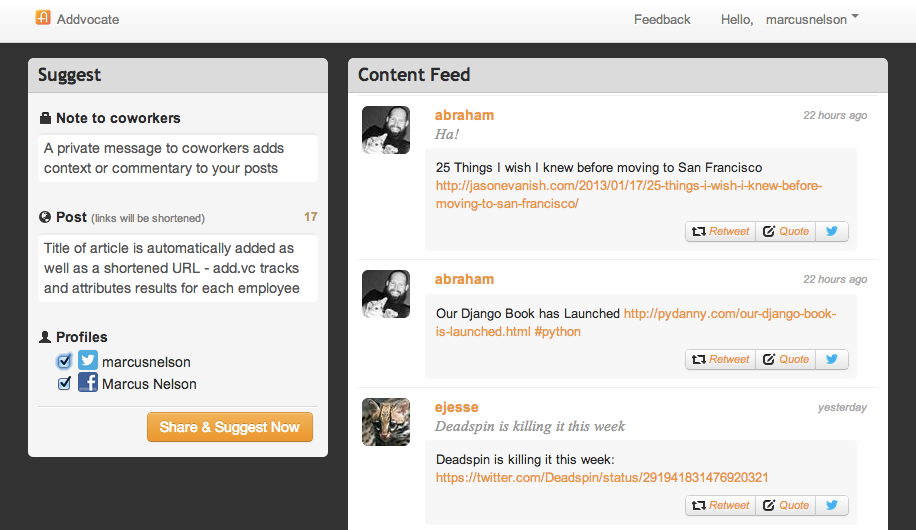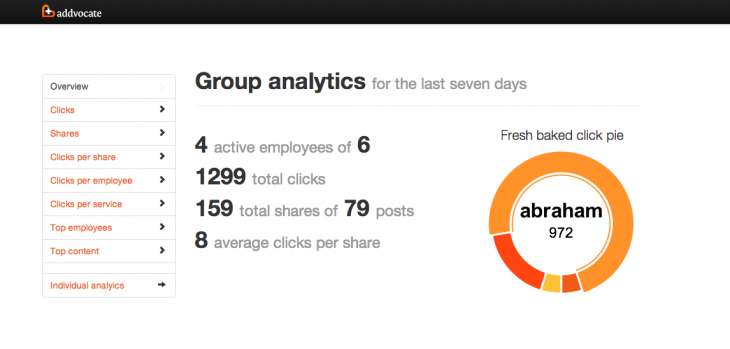
Addvocate, the employee advocacy and coordination platform, has moved into a ‘paid beta’ freemium model with a campaign that it hopes will attract more companies to sign up. As part of a 30-day experiment, customers can sign up and pick their own price, which it will continue to pay for the next six months.
Who is the internal champion?
Started by Marcus Nelson, one of the co-founders of customer service platform UserVoice and the former Director of Social Media at Salesforce, and Abraham Williams, Addvocate is geared towards solving a real problem that Nelson says he had while working in the trenches. As he was overseeing the social media team, there were three issues he faced:
- He never knew who was representing the company in social media — just who were the internal champions? When he joined Salesforce, there were 3,200 employees. Three years later, there were 8,500. In-between that time, he says that he didn’t know who would handle which responsibility.
- How can an employee’s role in social media be measured within the company? Companies need to find a way to determine the Return on Investment (ROI).
- How can these social media people be activated when you need them? If there is an issue that needs to be addressed or if you need to have a message be sent to customers, just how can you motivate internal teams to act? Nelson says that sure, you can use collaboration suites like Yammer or Chatter, or even email, but eventually you’ll get fatigue setting in. The employees will start to ignore the messages and move on about their business.
With these problems in mind, Addvocate was formed to help resolve them by organizing segment groups of socially active workers, mobilize voices, and help measure results — with action directly associated with individuals, not the company at large. It took Nelson and Williams months to develop a prototype and only recently “put the accelerator on” and hired the team from social search service YourTrove to help assist in the development. Now it is ready to move into its next phase that hopefully will increase its customer base.
‘Pick-what-you-pay’
Calling it a ‘paid beta’ freemium model, any potential customer who is interested can sign up and choose their own price. Yes, that’s right: for the next 30 days, the company is giving potential customers the freedom to choose whatever price they’re willing to pay per user per month. The dynamic price ranges from $1 per user per month up to $25. You can also choose how many users you wish to invite from 1 to 100, although if you need more than 100 licenses, Nelson says that he can help you with that.
The price that the customer sets will remain fixed for the next six months. However, anyone that enrolls after the 30-day period will pay a separate price, which is still to be determined — Nelson tells us he hopes that this campaign will help the company determine what that price point will be.
Nelson fully realizes that there is a risk for customers to sign up in droves and elect to pay $1 per user per month, but he believes that in the end, people will understand that by paying a reasonable price, they will receive something back in return and have the opportunity to provide input on the future of the product.
All transactions are managed through Stripe and what customers will pay right away is the cost of a single user license. Should more than one license be selected, only those that are used will be billed. By that, they mean if you say that 50 users will be on Addvocate but only 25 actually use it, then you pay for the 25 users. However, Addvocate will display the estimated maximum monthly charges to let you know what you could be paying.
How social media helps in advocacy
With Addvocate, customers are able to use the service to help track the social voices of the business while also building up a community. As Nelson puts it: “Imagine you could join the conversation your employees are having about your brand, figure out who they are, and validate them for it.”
After signing up, the administrator can invite anyone they want within the organization (they must have a company email address — Gmail addresses are prohibited). After an employee has opted-in, they can select content that they wish to share on their personal social networks. Addvocate functions as a Chrome plugin or as a bookmarklet for those with Internet Explorer or FireFox. When an employee visits a website or page and there’s something they wish to promote to their followers, they need only click on the Addvocate browser plugin and it will be added to system.
From here, internal messages can be affixed to the post so that others can receive instructions on what to do with the information. Whether it’s asking colleagues to retweeet it, respond to the posting, or anything else, customers could think about Addvocate as being like a social media backchannel.
Anything posted into Addvocate can be shared to social networks as well, including Twitter and Facebook. Nelson says that in the future, it is looking to add LinkedIn, Pinterest, and Google+, but in the meantime, it’s starting with the big networks and says it will move on from there.
Administrators are given the ability to track engagement in their Addvocate account. Over a period the last seven days, companies can monitor a variety of metrics such as clicks, shares, clicks per share/employee/service, top employees, and top content. Available through a dashboard, this enables employees to be recognized for their work and accountable for the results.
Teach a man how to fish versus giving him one
Some may compare Addvocate to being similar to customer advocacy services like Influitive, Extol, or Zuberance. However, it appears to be much different from those services. As Nelson tells us, with customer advocacy, businesses are turning to external parties to be champions and evangelists, all through some sort of incentive — whether its monetary or some other form. He says the big difference between those companies and his is that if you’re doing physical goods, it’s not going to be sustainable — the moment you open up that door, people are going to continue to expect it.
Nelson believes that rather than an incentive, simply acknowledging that it’s playful and light-hearted will go a lot farther with employees than customers. He recommends keeping it fun and real, but don’t turn it into an issue about fiscal rewards.
Many times we have heard that the greatest champion in any organization is the employees themselves. With Addvocate, the hope is that these individuals will be taught and be motivated to help spread the word to the community versus having customers be rewarded for having a Pavlovian response to a company’s promotional need.
Privacy
One of the concerns that employees when it comes to social media and the workplace is privacy. With Addvocate, users can plug their accounts into the platform in order to send tweets, post things to their wall, and more. This opens up the door for employers to have access to personal accounts. Nelson says this is untrue. Anything that is posted directly into Addvocate is recorded, but users have the ability to share things outside of the service. So if there is anything personal that needs to be tweeted or shared on Facebook, it’s best to do so using another client, not by clicking on the browser plugin or bookmarklet.
Addvocate currently has more than 36 companies using it. It has mostly been self-funded, except for a small angel round of funding including Scott Banister, Jesse Engle and Kyle Sollenberger from CoTweet/ExactTarget, Jin Koh, an early investor in UserVoice, Ed Nusbaum, Todd Richardson, Yi Lee, and Tim Kopp.
Photo credit: GIUSEPPE CACACE/AFP/Getty Images
Get the TNW newsletter
Get the most important tech news in your inbox each week.








